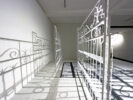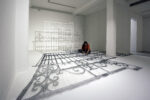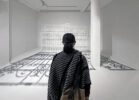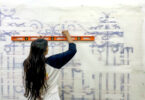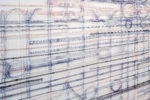Afterlife
Solo Exhibition, Exhibit 320, Delhi
Afterlife: 50 sec video walk through
Thread installations, animations and framed drawings.
Afterlife (Phantoms and Shadows)
Thread and steel frame
dimensions variable.
Afterlife (Phantoms and Shadows)
Thread and steel frame
dimensions variable.
Detail: Afterlife (Phantoms and Shadows)
Thread and steel frame
dimensions variable.
Process: Afterlife (Phantoms and Shadows)
Thread and steel frame
dimensions variable.
Afterlife (Phantoms and Shadows)
Thread and steel frame
dimensions variable.
The Unraveling Image
Threads pinned 1″ away from wall. Colours inspired by fading blueprints.
22ft X 8ft (size can vary)
Detail: The Unraveling Image
Threads pinned 1″ away from wall. Colours inspired by fading blueprints.
The Unraveling Image
Threads pinned 1″ away from wall. Colours inspired by fading blueprints.
22ft X 8ft (size can vary)
Process: The Unraveling Image
The Unraveling Image
Threads pinned 1″ away from wall. Colours inspired by fading blueprints.
22ft X 8ft (size can vary)
Installation view
Untitled (Fragmented Spiral Staircase)
Threads of varying thicknesses
91″ X 47″
84″ X 33″
59″ X 49″
Untitled (stair fragment)
Thread and Steel frame. Colours inspired by fading blueprints.
38″ X 49″
Installation view
Detail: Untitled (staircase to the First floor)
thread
Untitled ((staircase to the First floor)
thread
Approximate volume of the space: 10ft X 10ft X 10ft
Installation view
Entropy (veda doors)
Thread in the colours of fading blueprints.
Approximately : 7 ft X 12 ft
The form of the Veda doors starts dense and gets increasingly rarer, finally unraveling into 3 strings.
Untitled (corner brick fragment)
thread
135″ X 19″
Detail: Entropy (veda doors)
Thread in the colours of fading blueprints.
Approximately : 7 ft X 12 ft
The form of the Veda doors starts dense and gets increasingly rarer, finally unraveling into 3 strings.
Entropy (veda doors)
Thread in the colours of fading blueprints.
Approximately : 7 ft X 12 ft
The form of the Veda doors starts dense and gets increasingly rarer, finally unraveling into 3 strings.
Installation view:
Brick wall : 77″ X 47″,
Stair Fragment 38″ X 49″
and Staircase to the First Floor
Installation view with
Brick wall : 77″ X 47″
and
As Structure Dissolves: 9 min, 22 secs
stop motion animation projected on translucent fabric.
Still from : As Structure Dissolves
stop motion animation projected on translucent fabric.
9 min, 22 secs
A door from the artist’s (now empty) family home, is constructed stitch by embroidered stitch. Ultimately the form mutates, fragments and dissolves back into its original material (thread), swirling like a galactic phenomenon, offering back into the universe its temporal gift of form, to be assimilated into the material of stars.
Installation view
Mural of Surya and his Seven Horses (with one missing)
thread
92″ X 54″
Details: Mural of Surya and his Seven Horses (with one missing)
thread
92″ X 54″
Installation view
Untitled (white stair and shadow)
white thread drawing and its shadow
67.5″ X 36″
Untitled (white bricks and shadow)
white thread drawing and its shadow
108″ X 22″
Process: The Unraveling Image
Process: The Unraveling Image
Process: The Unraveling Image
Process: As Structrure Dissolves
Fragmented, unraveling, weightless replicas of architectural elements from the artist’s (now unoccupied) family home in exact life-size dimensions.
Thread
Afterlife: text by Najrin Islam
In her artistic oeuvre, Sumakshi Singh reconfigures the familiar axes of experience by drawing illusions in line and trace. The concrete constitution of architectural facades dissolves into textile ephemera, creating a mise-en-scene of spectral architectonics. What happens to a place after its inhabitants are gone? What happens to form after it’s done serving its function? In Afterlife, Singh explores loss as a gradient, creating a series of impressionist images that linger long after the immediate has perished.
Uninhabitable, the delicate textile facades offer themselves as experiential maps of the artist’s ancestral home. Located on 33 Link Road, Delhi, the house was built by her now-deceased grandparents after they migrated to India post the 1947 Partition. Listed as her “permanent address” in all official documents, this family home was the site of innumerable gatherings, sleepovers, shared stories, births, weddings, and deaths. Currently unoccupied, the building stands as a phantom of a potent past. Singh started to look anew at its constituent objects and architecture, replicating them carefully with dimensional exactitude in thread, in homage to her grandmother’s love of embroidery. Mounted to scale in the gallery, the house breathes through its simulation, attesting to an intense artistic need for perusal, absorption, and ultimately, release.
Gossamer threads become porous membranes, as structures levitate in defiance of gravity. Shadows are lent substance through textile doubling, while austere walls waft like delicate scaffold. This house rejects the laws of physics, as foreground and background dissipate in their normative polarities; the architecture is experienced as an apparition. In contrast to Singh’s installations in pre- Covid times, these works reveal a distinct sense of unravelling. Departing from the defined and measured contours of her earlier hand, Singh’s concentrated experience of vulnerability, fear, and grieving during the pervasive malaise over the past two years percolated into her artistic sensibility. So while the essence of the form remains intact, the material betrays a rawness. The hand becomes a conspicuous trail and inscription, driven by the urge to make architectural sense of its own predicament. The threadwork on display then becomes, in Singh’s words, a “transitional tapestry”, situated in the collisions of time, space, and memory.
Through re-creation in embroidery, the ethereal house becomes a sentient archive. Memory is externalised on a material placeholder in thread, as the gates and doorways stand as spectres of their referents in 33 Link Road. Singh’s abode pulsates with her pain at the filial loss, which activates the space through sensorial transfer. Is the house slowly taking shape through these laborious exercises? Or is it liquefying to its bare essential? Drawn from memory and index, and relocated onto textile palimpsests, the house is both genesis and residue. Situated between the manifest and the “un-manifest”, it floats as a quiet reminder of thread’s illimitable adaptability to the length and weight of longing.
Threadwork
2023:
Exhibit 320, Delhi, India
CSMVS museum, Mumbai, India
KNMA (Kiran Nadar Museum of Art), Noida, India
2022:
Asia Pacific Triennial QAGOMA
2021:
Aicon Contemporary, New York & 1X1 Art Gallery, Dubai
2020:
Kiran Nadar Museum of Art, Delhi
2019:
Sakshi Gallery, Mumbai, India
Hermès, The Chanakya, New Delhi
2019-current:
Architectural Thread Drawings
2018:
Wilfrid Israel Museum, Israel
Belgrade Biennale/ 58th October Salon, Serbia
2017:
Dr. Bhau Daji Lad Mumbai City Museum
India Art Fair/ FOCUS
C24 Gallery, New York, USA
2016:
Exhibit 320, New Delhi, India
Saatchi Gallery, London, UK & Art Houz, Chennai, India
2015:
SPACE, Wood Street Galleries, Pittsburgh, USA
2015-current:
Botanical Thread Drawings & Vitrines





































